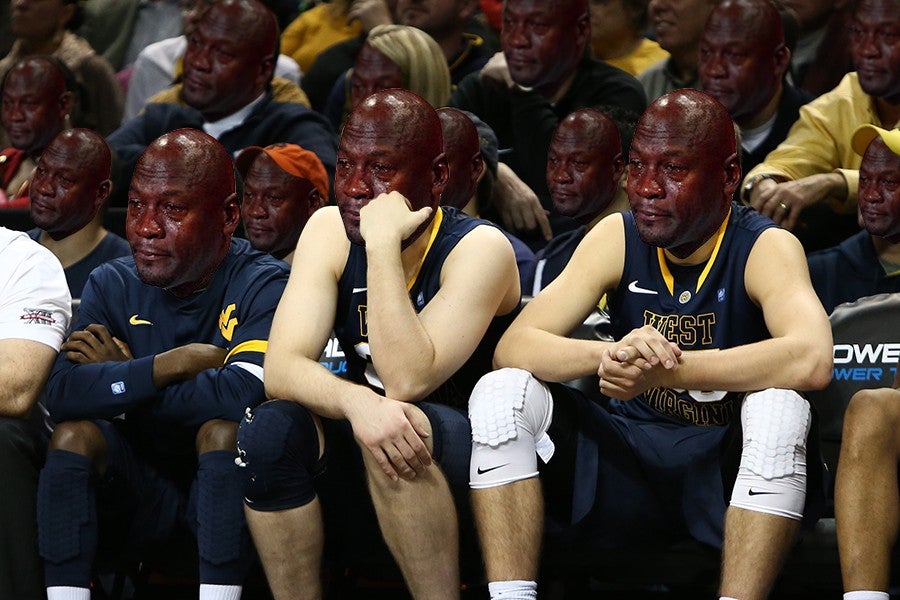Eleven years ago, Gonzaga forward Adam Morrison cried after his team lost in stunning fashion to the UCLA Bruins in the NCAA basketball tournament, a display of emotion for which he was excoriated in the press, and which he has never been able to live down.
“I got murdered for it,” Morrison said of his crying in an interview Monday with Barstool Sports’ Pardon My Take podcast. “I was kind of shocked by how much negative feedback I got.”
Indeed, fans have taken delight in Morrison’s crying jag ever since, never missing an opportunity to circulate images of his post-defeat ugly cry. What these fans are saying without actually saying it is that Morrison acted like a Nancy-boy pussy for crying after a loss, which is sacrilege within the manly confines of high-level athletic competition and unbefitting a player of Morrison’s caliber.
But that was in the early aughts. Now we’re in the late teens, and crying in basketball is popular! So many college players broke down into tears after heartbreaking losses in this year’s tournament that crying is no longer the anomaly it once was. Crying might even be cool.
A few pertinent examples: Kentucky freshmen De’Aron Fox and Edrice “Bam” Adebayo embraced one another and cried into cameras in an interview after their loss to championship favorite North Carolina on March 26:
Oregon’s Jordan Bell cried on Saturday after he failed to box out and secure rebounds late in the team’s loss to North Carolina:
An emotional Jordan Bell takes the blame for Oregon's loss (?: @Pac12Network) pic.twitter.com/YgTWlp4hk6
— Sports Illustrated (@SInow) April 2, 2017
And Trevon Bluiett of Xavier was shown on TV crying during the team’s loss to Gonzaga, which will play UNC in the national championship game tonight.
I was doing ok until seeing Bluiett crying like that. Damn.
— Mike Lindeman (@MikeTLindeman) March 26, 2017
What the hell happened between Morrison and now that it’s so much more common for NCAA basketball players to weep in public?
Let’s not discount that these players are millennials and thus, like me, grew up coddled and unfamiliar with the concept of failure. And despite what the election might reflect, society is more accepting of outward expressions of emotion from men.
But this amount of crying seems like a lot.
It’s so common for players to cry after a loss that it’s almost expected at this point —if you don’t cry, maybe you didn’t care as much as the man who’s weeping. Indeed, some of these crying performances feel like the players are putting on a little bit.
We’re soon going to have self-important sports writers writing hit pieces about the collegiate athletes who remain stoic in defeat, calling them selfish and questioning their emotional commitment to the team’s success.
Previously, the only acceptable form of sports crying was during the National Anthem, because that meant the player loved his country to the point of moving him to tears.
A notable exception was Michael Jordan, who openly sobbed on the floor after the Bulls won the NBA title in 1996. But his crying didn’t come across as a sign of emotional weakness, mainly because it was seen as a tribute to his father, who had passed away earlier that year. Also, no one questioned anything Jordan did back then. This was decades before the Crying Jordan meme desecrated his legacy and Jordan was still more or less unassailable.
Cristiano Ronaldo's bust didn't turn out as planned…
Credit – @bighurtrocks pic.twitter.com/ExYtpkjcsI
— Crying Jordan (@CryingJordan) March 29, 2017
It might be too much to say Morrison normalized crying after defeat, but he’s certainly the pioneer in this emerging trend—here’s hoping his long-ago tears will finally stop haunting him. Gonzaga winning its first national championship would certainly help overshadow that memory.
After all, then everybody associated with the program will be crying.
